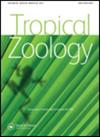缅甸北部Hukaung山谷旱季有蹄虎猎物的栖息地占用
IF 0.4
4区 生物学
Q4 ZOOLOGY
引用次数: 0
摘要
我们评估了主要虎(Panthera tigris)有蹄类猎物物种的栖息地占用和分布,以评估影响其发生的因素,以及它们对缅甸北部Hukaung Valley野生动物保护区核心部分老虎数量减少的潜在贡献。在2007年11月至2008年5月期间,我们调查了1651公里的样带上的标志,这些样带被划分为554个采样单元。通过纳入七个环境和四个社会协变量,我们预测了高鹿(Bos gaurus)的栖息地占用率为0.76,桑巴(Rusa unicolor)为0.91,野猪(Sus scrofa)为0.57,北方红魔芋(Muntiacus vaginalis)为0.89。总体而言,到护林员站和小径的欧几里得距离较短,溪流密度降低,常绿/半落叶阔叶林和相对罕见的雨水灌溉农田栖息地的出现对猎物栖息地的占用产生了积极影响;相反,距离村庄、道路和溪流较短的欧几里得距离、较高的海拔以及阔叶林和针叶林混合栖息地的出现对占用率产生了负面影响。此外,到护林员站、小径和道路的欧几里得距离对物种检测有积极影响,而到村庄和溪流、高海拔和高降水的较短欧几里得距离则对物种检测产生负面影响。结果表明,所有四种猎物在保护区核心区分布相对良好,但与其他地方的丰度指数相比,猎物密度较低,不太可能支持许多老虎。本文章由计算机程序翻译,如有差异,请以英文原文为准。
Dry-season habitat occupancy by ungulate tiger prey in the Hukaung Valley of northern Myanmar
We assessed habitat occupancy and distribution of principal tiger (Panthera tigris) ungulate prey species to assess factors affecting their occurrence and their potential contribution to low tiger presence in the core part of the Hukaung Valley Wildlife Sanctuary, in northern Myanmar. We surveyed for signs on 1,651 km of transects partitioned into 554 sampling units between November 2007 and May 2008. By incorporating seven environmental and four social covariates, we predicted habitat occupancy rates of 0.76 for gaur (Bos gaurus), 0.91 for sambar (Rusa unicolor), 0.57 for wild pigs (Sus scrofa), and 0.89 for northern red muntjac (Muntiacus vaginalis). Overall, shorter Euclidean distances to ranger stations and trails, decreased stream density, and broadleaved evergreen/semi-deciduous forest and relatively rare rain-fed cropland habitat occurrence positively influenced prey habitat occupancy; conversely, shorter Euclidean distances to villages, roads, and streams, higher elevations, and occurrence of mixed broadleaved and needle-leaved forest habitat negatively influenced occupancy. In addition, Euclidean distance to ranger stations, trails, and roads positively affected species detections, whereas shorter Euclidean distance to villages and streams, high elevations, and high precipitation negatively affected detections. Results indicated that all four prey species were relatively well-distributed through the Sanctuary core area, but comparisons with indices of abundance elsewhere suggest that prey density was low and would not likely support many tigers.
求助全文
通过发布文献求助,成功后即可免费获取论文全文。
去求助
来源期刊

Tropical Zoology
生物-动物学
CiteScore
2.50
自引率
0.00%
发文量
1
审稿时长
>12 weeks
期刊介绍:
Tropical Zoology is an international zoological journal publishing original papers in the field of systematics, biogeography, phylogeny, ecology and conservation of all terrestrial and aquatic animal Phyla from tropical and subtropical areas.
Only papers with new information, high quality and broad interest are considered. Single species description and checklists are not normally accepted. Review papers are welcome. The journal is owned by the Istituto di Ricerca sugli Ecosistemi Terrestri of the Consiglio Nazionale delle Ricerche, Florence, Italy (CNR-IRET) who performs research into the structure and functioning of aquatic and terrestrial ecosystems, focusing in particular on anthropogenic pressure and global change. The knowledge amassed forms the scientific basis for identifying the most appropriate protective and corrective interventions, and provides support for the bodies entrusted with formulating policies for environmental protection and recovery.
 求助内容:
求助内容: 应助结果提醒方式:
应助结果提醒方式:


